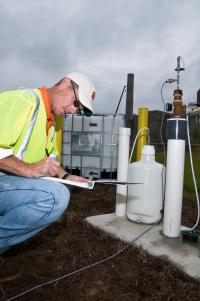Researchers from one of the National Laboratories of the US Department of Energy (SRNL) and Clemson University have developed a collection of bacteria that have an "appetite" for pollutants that contain chlorine.

Researchers from the US Department of Energy have succeeded in cleaning chemically contaminated groundwater using natural bacteria.
Part of a certain geographic area in the US is contaminated with volatile organic compounds containing chlorine, compounds similar to those present in dry cleaning fluids. Researchers from one of the National Laboratories of the US Department of Energy (SRNL) and Clemson University have developed a collection of bacteria that have an "appetite" for substances of this type.
"If these bacteria are really as effective as we anticipate for cleaning chemical contaminants found in groundwater, then this method will be much cheaper than other ways of cleaning, such as methods of "pumping and treating" or heating the ground," notes Mark Amidon, director the venture.
The mixture of bacteria was found naturally in the same area being tested, where they were fed by the same type of chemical that seeped into the groundwater through nearby streams. The scientists examined and characterized the mixture of bacteria and gave it the name MicroCED ("microbiological-based chlorinated ethene destruction"). When it is injected below the surface of the ground, it fully converts hazardous solvents such as chlorinated ethylenes into safe and non-toxic products.
The researchers explain: "Last summer we introduced more than twenty thousand liters of soybean oil, chemical treatment materials and more than four hundred thousand liters of water in order to obtain dissolved oxygen levels and the appropriate level of acidity," explains the chief researcher. "As soon as we achieved the appropriate conditions, we started injecting the stock of bacteria that we had grown in cultures. In an initial experiment we needed about eighty liters of bacteria to start the cleaning. At the end of the demonstration, we discovered that about six thousand liters of bacteria could be injected into the site.
The researchers estimate that only a full year later will the desired effects be exerted. The test area is 40-30 square meters in size and is located approximately 35 meters below ground level, and is to be used to determine if this approach can be applied for full-scale cleanup of the area.
The aforementioned laboratory examines methods of biological treatment of infections by utilizing existing microorganisms for many years. The difference in the current study lies in the cultivation and introduction into the soil of a defined mixture of bacteria in order to neutralize chlorinated solvents.
